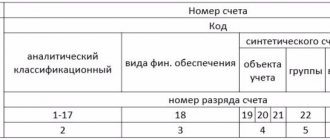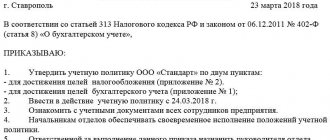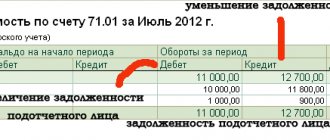Scope of application
The chart of accounts is a list systematized on the basis of the economic content of each position included in it. The current list is a mandatory basis for drawing up a working chart of accounts for all organizations operating on the territory of the Russian Federation and maintaining accounting using the double entry method. The exception is banks and government agencies.
The double entry method is a registration system that involves simultaneous reflection of a transaction on two accounts: withdrawal ( credit ) of a certain amount of money from one and receipt ( debit ) of the same amount to another account .
Typical transactions for account 51 “Current accounts”
Business transactions on the debit of account 51 “Current accounts”
| № | Contents of business transactions | Source documents | Corresponding accounts | |
| Debit | Credit | |||
| 1 | 2 | 3 | 4 | 5 |
| 1 | Cash received from the cash register to the account | Bank statements, announcement for cash deposit, bank receipt for accepting cash | 51 | 50 |
| 2 | Received funds from foreign currency accounts | Bank statement for a foreign currency account, bank statement for a current account | 51 | 52 |
| 3 | Unused amounts of letters of credit, checks, bank cards, deposits were returned to the current account | Bank statement for current account, bank statement for special accounts | 51 | 55 |
| 4 | Received funds in transit (money transfers, collection of proceeds) | Bank account statement | 51 | 57 |
| 5 | In order to repay the provided long-term and short-term loans to another organization, funds were transferred to the current account | Bank account statement | 51 | 58 |
| 6 | Receipts from suppliers and contractors (refund of prepayments, advance transfers, overpayment amounts) | Bank account statement and payment order | 51 | 60 |
| 7 | Reflects revenue from buyers and customers for supplied finished products, work performed, services rendered | Bank statement on current account, payment order, payment request | 51 | 62 |
| 8 | Funds were received from bank loans and other loans: A) short-term B) long-term | Bank account statement, documents for obtaining short-term and long-term loans and borrowings | A) 51 B) 51 | A) 66 B) 67 |
| 9 | Amounts of overpayments on taxes and fees were returned from the budget based on the results of recalculation | Bank statement on current account, payment order | 51 | 68 |
| 10 | The organization was reimbursed by the social insurance fund for the costs of paying various benefits | Bank statement on current account, payment order | 51 | 69/1 |
| 11 | The amount of overpayments based on the results of the recalculation was returned from extra-budgetary funds | Bank statement on current account, payment order | 51 | 69 |
| 12 | Revenues for sold products and goods are credited to the account listed by accountable persons | Bank account statement, postal transfer receipts | 51 | 71 |
| 13 | Reflects amounts received from employees of the organization, loan repayment, compensation for material damage | Bank account statement, postal transfer receipts | 51 | 73 |
| 14 | Funds for the contribution to the authorized capital were transferred to the current account | Bank statement on current account, payment orders | 51 | 75 |
| 15 | Funds were received into the current account from various organizations and individuals to pay off accounts receivable; credited are the amounts of satisfied claims, dividends on securities, interest on debt obligations of other organizations, income from participation in the authorized capital of other organizations, distributed profits from joint activities, funds from subsidiaries | Bank statement on current account, payment orders | 51 | 76 |
| 16 | The amounts of insurance compensation received by the organization from insurance companies are credited | Bank statement on current account, payment orders | 51 | 76 |
| 17 | Received funds for targeted financing | Bank statement on current account, payment orders | 51 | 86 |
| 18 | Funds received as emergency revenues as a result of an emergency situation | Bank account statement | 51 | 99/4 |
| 19 | The parent organization's account received funds from a structural unit accounted for on a separate balance sheet | Bank account statement | 51 | 79 |
| 20 | Cash received as deferred income | Bank account statement | 51 | 98/1 |
Structure
The chart of accounts is characterized by a strict structural hierarchy, which is based on:
- synthetic accounts
– designed to record generalized information about transactions, types of property, liabilities; - subaccounts
– used to obtain detailed data.
Subaccounts can be combined or excluded from the organization's working chart of accounts. Company specialists can introduce additional subaccounts. However, changing the names and purposes of synthetic accounts is unacceptable. Based on the division of the balance sheet into assets and liabilities, the following types of accounts are distinguished:
- active
– accounting for the movement of funds at the disposal of the enterprise; - passive
- accounting for sources of funds, displaying information about profits, types of capital, and obligations of the organization; - active-passive
– cumulative accounting of property and sources of its formation.
Off-balance sheet accounts
Off-balance sheet accounts are classified as auxiliary accounts. They are used in cases where an accountant needs to systematize information that is not stored on the company’s balance sheet. These accounts record information about the movement of property that does not belong to the organization, but is temporarily in its use, or assets of the enterprise written off as expenses.
Important: Off-balance sheet account data is not reflected in the financial statements.
The chart of accounts provides for 12 off-balance sheet accounts:
- 001 - leased fixed assets (fixed assets);
- 002 - inventory items accepted for safekeeping;
- 003 - materials accepted for processing;
- 004 - goods accepted for commission;
- 005 - equipment accepted for installation;
- 006 - strict reporting forms;
- 007 - debt of insolvent debtors written off at a loss;
- 008 - security for obligations and payments received;
- 009 - security for obligations and payments issued;
- 010 - OS wear;
- 011 - fixed assets leased;
- 012 - land.
Instructions for the Chart of Accounts
The instructions help to simplify and systematize work with the Chart of Accounts. Its use allows:
- obtain basic information about the methodological principles of accounting;
- get acquainted with a brief description of synthetic and subaccounts;
- understand the accounting procedures for typical transactions.
Drawing up a working chart of accounts for an organization in accordance with the provisions of the Instructions makes it possible to organize a unified standardized approach to accounting and preparation of financial statements.
What is a chart of accounts?
Charts of accounts are consolidated documents approved by regulatory legal acts at the federal level.
There are several industry-specific types of relevant documents. Thus, the chart of accounts for the commercial sector was approved by order of the Ministry of Finance of Russia dated October 31, 2000 No. 94n. Russian taxpayers must use this document as the basis for creating an internal accounting work plan (paragraph 4 of the Instructions for using the chart of accounts, approved by Order No. 94n).
The accounting plan is a key source for completing the documents that make up the organization's balance sheet. A little later we will look at how their components relate to each other.
In accordance with the internal work plan accounts, firms operating in the Russian Federation carry out standardized accounting of various business transactions related to asset management, fulfillment of obligations, expenditure of funds, extraction of income, etc.
The main elements of the chart of accounts approved by the Ministry of Finance for private companies are as follows:
- numbers and names of main accounts;
- numbers and names of subaccounts.
When forming its own work plan, the organization does not have the right to change the first 2 parameters, but the parameters of subaccounts can. If necessary, the firm can also approve additional subaccounts.
As a rule, to effectively reflect business transactions, the accounts proposed by the Ministry of Finance require further detail. The company can do this by introducing its own analytical accounts, supplementing those recorded in Order No. 94n.
In the Guide to Account Correspondence from ConsultantPlus, you will find typical transactions for any account. If you do not have access to the K+ system, get a trial online access for free.
Let's look at what other accounting plans there are.
Accounting table
Below is a table with an approved list of accounting accounts. Each position contains a link to a page with reference information that provides answers to the most common questions and allows you to study in detail the specifics of working with a specific account.
| Accounting account | Account name |
| 01. | Fixed assets |
| 02. | Depreciation of fixed assets |
| 03. | Profitable investments in material assets |
| 04. | Intangible assets |
| 05. | Amortization of intangible assets |
| 07. | Equipment for installation |
| 08. | Investments in non-current assets |
| 09. | Deferred tax assets |
| 10. | Materials |
| 11. | Animals being raised and fattened |
| 14. | Reserves for reduction in the value of material assets |
| 15. | Procurement and acquisition of material assets |
| 16. | Deviation in the cost of material assets |
| 19. | Value added tax on purchased assets |
| 20. | Primary production |
| 21. | Semi-finished products of our own production |
| 23. | Auxiliary production |
| 25. | General production expenses |
| 26. | General running costs |
| 28. | Defects in production |
| 29. | Service industries and farms |
| 40. | Release of products (works, services) |
| 41. | Goods |
| 42. | Trade margin |
| 43. | Finished products |
| 44. | Selling expenses |
| 45. | Goods shipped |
| 46. | Completed stages of unfinished work |
| 50. | Cash register |
| 51. | Current accounts |
| 52. | Currency accounts |
| 55. | Special bank accounts |
| 57. | Transfers on the way |
| 58. | Financial investments |
| 59. | Provisions for impairment of financial investments |
| 60. | Settlements with suppliers and contractors |
| 62. | Settlements with buyers and customers |
| 63. | Provisions for doubtful debts |
| 66. | Calculations for short-term loans and borrowings |
| 67. | Calculations for long-term loans and borrowings |
| 68. | Calculations for taxes and fees |
| 69. | Calculations for social insurance and security |
| 70. | Payments to personnel regarding wages |
| 71. | Calculations with accountable persons |
| 73. | Settlements with personnel for other operations |
| 75. | Settlements with founders |
| 76. | Settlements with various debtors and creditors |
| 77. | Deferred tax liabilities |
| 79. | On-farm settlements |
| 80. | Authorized capital |
| 81. | Own shares (shares) |
| 82. | Reserve capital |
| 83. | Extra capital |
| 84. | Retained earnings (uncovered loss) |
| 86. | Special-purpose financing |
| 90. | Sales |
| 91. | Other income and expenses |
| 94. | Shortages and losses from damage to valuables |
| 96. | Reserves for future expenses |
| 97. | Future expenses |
| 98. | revenue of the future periods |
| 99. | Profit and loss |
You can download the table with the chart of accounts here.
Table with explanation of charts of accounts with subaccounts
The accounting table for 2019 and 2021 is as follows:
List of accounts
| Number | Account name | Brief Explanation |
| 01 | Fixed assets | Displays general information about property, buildings that are operated or rented by the company. Subaccount: by type of fixed assets (active, inventory). |
| 02 | Depreciation of fixed assets | The cost of depreciation of intangible and tangible fixed assets that have accumulated during their use. |
| 03 | Profitable investments in material assets | This category highlights a company's investments in the rental of material assets for the purpose of generating income. For example, renting premises for a store, equipment for the production of goods, etc. Subaccount - “Disposal of material assets”. |
| 04 | Intangible assets | Intangible asset expenses include income or expenses for patents, commercial research, idea development, scientific work, and design projects. They cannot be measured in real terms, but they have their own material value. Subaccounting is carried out by type of assets and by expenses for various works. |
| 05 | Amortization of intangible assets | Loss of value of intangible assets that has accumulated during their use. Reflected in the loan. |
| 07 | Equipment for installation | Information about equipment that needs installation or configuration. For example, computer networks, equipment for production or laboratories, etc. |
| 08 | Investments in non-current assets | Reflection of assets that will subsequently be reflected as fixed assets. This broad category includes animals, land, and various works. |
| 09 | Deferred tax assets | This account contains taxes that the organization must pay. |
| 10 | Materials | Information about all materials that are used to operate a company or produce a product. For example, a company sells painted teapots and purchased unpainted goods for production. They should be included in this account. Subaccounts:
Materials refer to active accounts. The cost of raw materials or fuel before purchase is calculated according to the planned cost, which is calculated using average purchase prices. Next, take the actual price. |
| 11 | Animals being raised and fattened | As you can guess from the name, this account provides information about those animals that are not yet suitable for sale. As a rule, such cows, rabbits or birds are in feeding or fattening. |
| 14 | Reserves for reduction in the value of material assets | This section is intended to reflect the decrease in the amounts of material assets. As a rule, this happens if prices for feed, raw materials, fuel or finished products fall. |
| 15 | Procurement and acquisition of material assets | This account includes the purchase price of inventories that came from contractors, debtors or other sources. |
| 16 | Deviation in the cost of material assets | The difference between accounting prices and the actual cost of materials or inventories. Can be classified as either a debit or a credit. |
| 19 | Value added tax on purchased assets | Subaccounts:
|
| 20 | Primary production | Reflects the work or services that were used to fulfill the purpose of the institution. For example, if the goal was milk production, then this account reflects the output of agricultural products. |
| 21 | Semi-finished products of our own production | Semi-finished products that were produced by the company. |
| 23 | Auxiliary production | Additional costs that have an auxiliary function for production. |
| 25 | General production expenses | Those needs that are related to the main process only indirectly. |
| 26 | General running costs | Filling out this column is associated with general business expenses. |
| 28 | Defects in production | A collection of defective products. |
| 29 | Service industries and farms | Works and services that will be additional. This category includes expenses for food for employees, housing and communal services, organization of summer camps for children of employees, etc. |
| 40 | Release of products (works, services) | The actual cost of goods or work for a certain period. If for some reason the figure differs from the planned one, then this is also indicated in the accounting. |
| 41 | Goods | If an organization purchases goods for sale, they are indicated in this invoice. Subaccounts:
|
| 42 | Trade margin | If the company resells goods, then this section indicates their markup. |
| 43 | Finished products | Availability and movement of finished products. |
| 44 | Selling expenses | For example, packaging, delivery or fees to intermediaries. |
| 45 | Goods shipped | This category reflects those products that have already been shipped from the warehouse, but have not yet been paid for, that is, the revenue did not arrive immediately. |
| 46 | Completed stages of unfinished work | This account is usually used by organizations that perform long-term work: for example, construction companies. |
| 50 | Cash register | Subaccounts:
|
| 51 | Current accounts | |
| 52 | Currency accounts | |
| 55 | Special bank accounts | The position of funds held in letters of credit, check books or deposit accounts is indicated. |
| 57 | Transfers on the way | Funds deposited but not yet credited to the account. |
| 58 | Financial investments | Investments in securities, bonds or loans. |
| 59 | Provisions for impairment of investments in securities | Information about investing in securities. |
| 60 | Settlements with suppliers and contractors | Information on settlements with suppliers and contractors. |
| 62 | Settlements with buyers and customers | Calculations and reserves for relevant categories. |
| 63 | Provisions for doubtful debts | |
| 66 | Calculations for short-term loans and borrowings | Subaccounts according to the classification of loans and borrowings. |
| 67 | Calculations for long-term loans and borrowings | |
| 68 | Calculations for taxes and fees | Subaccounts by types of taxes and fees. |
| 69 | Calculations for social insurance and security | Subaccounts:
|
| 70 | Payments to personnel regarding wages | Information about payments to personnel. |
| 71 | Calculations with accountable persons | Payments to accountable persons. |
| 73 | Settlements with personnel for other operations | Subaccounts:
|
| 75 | Settlements with founders | Subaccounts:
|
| 76 | Settlements with various debtors and creditors | Information on payments to debtors and creditors that were not assigned to accounts 70 to 75. Subaccounts:
|
| 77 | Deferred tax liabilities | Information about the presence of deferred tax liabilities. |
| 79 | On-farm settlements | This category contains information about settlements with separate organizations. Subaccounts:
|
| 80 | Authorized capital | The state of the authorized capital is reflected. |
| 81 | Own shares (shares) | Information about purchased shares. |
| 82 | Reserve capital | State and movement of reserve capital. |
| 83 | Extra capital | State and movement of additional capital. |
| 84 | Retained earnings (uncovered loss) | Availability and movement of amounts of retained earnings. |
| 86 | Special-purpose financing | Availability and movement of funds that are needed to carry out various targeted activities. |
| 90 | Sales | A report on income and expenses that are related to the main activities of the organization. Subaccounts:
|
| 91 | Other income and expenses | Subaccounts:
|
| 94 | Shortages and losses from damage to valuables | The amount of shortages and damage to valuables. Upcoming expenses. Subaccounts: by type of reserves. |
| 96 | Reserves for future expenses | Data on expenses in the current reporting period. |
| 97 | Future expenses | Data on budget expenditures for future reporting periods. |
| 98 | revenue of the future periods | Estimated income for future periods. Subaccounts:
|
| 99 | Profit and loss | The final financial result of the organization's activities. |







